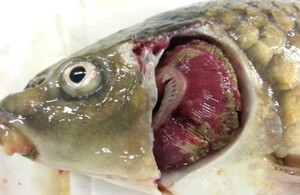I am sure you are all aware of the devastating impact that Koi Herpes Virus (KHV) can have on a fishery and its fish stock. The disease itself has spread through fish farms and fisheries since it was first identified in 1998.
Regretfully the disease is now widespread and has the ability to cause large scale fish mortality with the additional complication of the fishery being placed under strict biosecurity measures by the Fish Health Inspectorate (FHI), effectively closing the fishery until a time that the FHI release it for use once again.
KHV is triggered by two main factors, those being water temperature and stress. KHV outbreaks are more common in late spring and summer as the water temperatures are likely to have been between 16 degrees Celsius and 28 degrees Celsius. As we have experienced an extensive period of hot dry weather in the UK, this long-term temperature element is a very real risk factor for all fisheries. Fish stress can come in many forms including overcrowding and excessive handling, particularly at times where we are experiencing excessive temperatures.
In August alone, keeping in mind it is only the 9th day of the month, 8 instances of KHV have already been reported to the FHI, which is the equal to the cases reported through the entire month of July!
So, what can we do to reduce the risk of this devastating disease?
Firstly, I would ask that we are all mindful of the risk we present as Anglers, whether you fish for Carp, Tench, Bream or Small Silvers, we all present an equal risk of transferring the virus between venues.
This transfer can take place by bringing wet or dirty nets, boots, waders, or other fishing equipment to the bankside, as unclean tackle carries a real risk of disease transfer. Knowing how this virus is transferred you can;
Check – Check your equipment, and clothing after leaving the water for mud, aquatic animals or plant material. Remove anything you find and leave it at the site.
Clean – Clean everything thoroughly as soon as you can, paying attention to areas that are damp or hard to access. Use hot water if possible.
Dry – Dry everything for as long as you can before using elsewhere as some invasive plants and animals can survive for over two weeks in damp conditions. This sunny weather gives us all an opportunity to properly dry our equipment in the sunlight.
Some of the reported cases in our region have been at day ticket fisheries and it is entirely foreseeable that this virus can be spread fishery to fishery through low biosecurity. So please be mindful and check, clean and dry your kit between session and DO NOT bring any wet nets, slings, keepnets etc. to KDAA waters.
Bailiffs will continue to monitor the situation and should you have concerns or find dead or dying fish at any of our waters please report this to the Bailiff or the club.
Tight Lines!
Mark Wilson – Fisheries Manager

